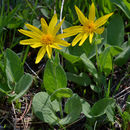en
names in breadcrumbs


Arnica cordifolia is a species of arnica in the sunflower family, known by the common name heartleaf arnica.[2] It is native to western North America.
This is a rhizomatous perennial herb producing one or more erect stems reaching a maximum height of about 60 centimetres (2 feet).[3] It has two to four pairs of leaves on the stem, each on a long petiole. The leaves are heart-shaped to arrowhead-shaped and finely toothed along the edges. The inflorescence bears one or more daisylike flower heads 5–9 cm (2–3+1⁄2 inches) in width,[3] lined with white-haired phyllaries and sometimes studded with resin glands. The center of each head contains golden yellow disc florets and a fringe of 10–15 bright golden ray florets approaching 3 cm (1+1⁄4 in) in maximum length.[3][4][5][6][7] The flowers usually bloom from April to June, but sometimes do so as late as September.[3]
The fruit is a hairy achene up to 1 cm (1⁄2 in) long, not counting its off-white pappus. Seeds are dispersed on the wind. An individual plant can live 12 years, surviving periodic wildfire by resprouting from its long, slender rhizome afterward.[7][8]
The species could be confused with the similar Arnica latifolia, from which it can be distinguished by the leaves. The leaves of A. cordifolia are larger and heart-shaped.[9]
It is native to western North America from Alaska to California to New Mexico, as far east as Ontario and Michigan.[10][11] It is a plant of many habitat types, including coniferous forests, and moist mountain meadows from sea level to altitudes of above 3,700 metres (12,000 ft), but most commonly between 1,200–3,400 m (4,000–11,000 ft).[10][7]
The dried leaves can be made into a poultice or tincture to treat strains and bruises.[12]
Arnica cordifolia is a species of arnica in the sunflower family, known by the common name heartleaf arnica. It is native to western North America.